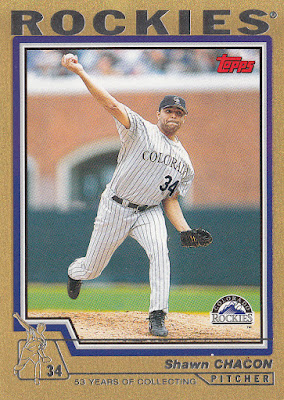 |
| 2004 Topps Gold #257 Shawn Chacon /2004 |
This is a gold parallel marking the milestone that was Topps' fifty-third year. Not exactly a nice round number, (a prime, in fact), but this was when Topps was still using actual gold lettering on serial numbers for this set. They moved to a plain black quite a few years ago, and dropped them entirely from Opening Day the past couple years.
Whether base or parallel, this 2004 card has a tiny foil outline in the lower left, duplicating in miniature the actual card's photograph.
 |
| 1998 SP Authentic Sheer Dominance Silver #SD27 Todd Helton |
After a trip to Beckett, turns out the rarest of the three varieties is actually Titanium.
 |
| 1999 Fleer Tradition Warning Track #123W Mike Lansing |
Rockies 2B Mike Lansing has some great wraparound shades on this photo, but what I really like about this card is that the card number is different from the base set! Fleer added a "W" after the card number, clearly indicating that it's something unusual. I'd really love to see Topps do that, and the new-for-2016 "OD" prefix on Opening Day card numbers bodes well for this element finding its way back into the Hobby.
 |
| 1998 Topps Stars Gold #131 Todd Helton /2299 |
There's even a trivia question on the back, mentioning Helton's QB days at the University of Tennessee, and asking which then-active American League first baseman was a kicker for the University of Nebraska. Unfortunately, we have to look at card #132 to find the answer. I know of absolutely no one who has completed 1998 Topps Stars, so I'll just have to Google that one.
Survey says...Darin Erstad. Actually I knew that at one point. My high school psychology teacher was a Cornhusker and asked this question in class one day, even giving us the clue that he was an Angel. I incorrectly guessed Chad Curtis. Sorry, class. I don't think we got to leave early that day.
Incidentally, if you own card #130 in this set and have been wracking your brain for two decades for the answer to whatever trivia question your card contains, the answer is Jim Sundberg.
 |
| 2000 Topps Tek Pattern 2 #23-2 Larry Walker |
Topps Tek actually reeled it in a bit for 2000, offering only 20 possible background variations, compared to earlier years that had up to 90. Still, completing a set like this would be an exercise in madness. It reminds me a bit of those gigantic jigsaw puzzles seen toward the end of Citizen Kane.
 |
| 1998 Topps Gold Label Class 1 #81 Todd Helton |
These always reminded me of 1993 Flair. Soft focus, really thick card stock, thin foil lettering. Pretty much the only difference is the rainbow finish.
 |
| 1998 Topps Gold Label Class 2 Black Label #81 Todd Helton |
Does this one look familiar to you? It's sort of the same card. But not. It's kind of like a parallel, but it isn't entirely so. It has the same card number (and the same back), but this is a "Class 2" version of Helton's card, offering us a different foil color and a different action shot (baserunning instead of fielding). But the "Black Label" makes it a parallel of Class 2 (a color actually found in all three classes), whereas Class 2 itself is more of a variation. And the Black Label only refers to the logo, not the player's name.
To sum up, it's definitely a parallel of something that is a quasi-parallel.
I don't know. It's late. I ought to hire a theoretical physicist to explain this thing.
Also, it took me a really long time to notice that the foreground shot (the smaller, post-swing photo) doesn't change between classes.
 |
| 1998 Topps Gold Label Class 3 #81 Todd Helton |
I know we all gripe about how many colored parallels there are these days, along with all sorts of things that make it hard to please us collectors, like recycled photos, general design elements, under-representation of our preferred team. But for me, the key question this: is it easy for me to understand what I am holding? Topps' photo variations and Bowman are key offenders here. On their own, photo variations are an OK concept, but unless you know the base set like the back of your hand, it's pretty tough to know whether you have a variation or just a common card. More often than not, they could probably just make the base set as a whole better by just using the variation as the primary photo. And don't even get me started on all those Bowman Chrome Prospect cards.
I know I said I wasn't going to rehash all the fractured set nonsense. But it's such a convoluted thing that I can't help but try to talk it out, even for my own understanding.
Regardless, they're nice-looking cards, and I more-or-less have a rainbow of these Helton cards thanks to this trade.
But the late 1990s were clearly a crazy time. Y2K was just around the corner.
On a final note, Opening Day is no longer around the corner! Every team has a game under its belt now, including the Rockies with a 4-hour marathon 10-5 win over Zack Greinke and the Diamondbacks. Not great for my Fantasy team, but Trevor Story is on pace for 324 home runs this year, after hitting two home runs in his first three Major League at bats!
And Happy Birthday, dad!

I feel like I did when I was teaching...piling on the homework! Glad to add some new cards to your collection.
ReplyDelete#supertraders
ReplyDelete